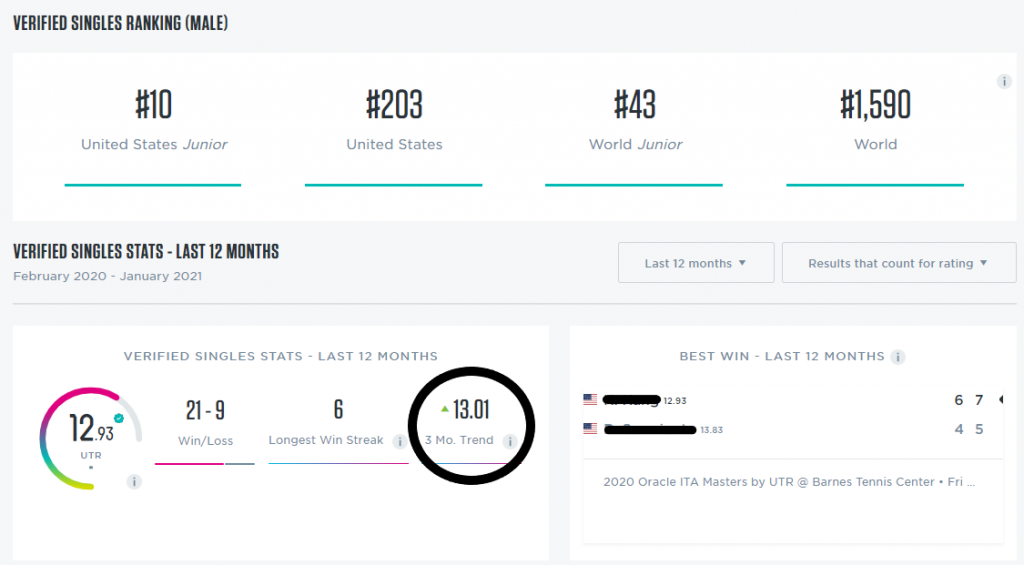While tennis’ international nature has often been celebrated, the sport always lacked a unified rating system until UTR Sports (formerly Universal Tennis) came along with the UTR Rating, powered by its unique algorithm.
We're outlining the UTR Rating basics below by diving into the UTR Rating algorithm and answering, “What is UTR Rating?”
Professionals had ATP/WTA rankings, but what about 99.9% of tennis players around the world? Because of this lack of a worldwide rating system, tennis enthusiasts of all ages from recreational to college players had no idea where they fit on a global scale.
By comparison, golf had a handicap system where just by knowing a player’s handicap, you could know their level.
What is UTR Rating?
UTR Rating is a system created by UTR Sports that promotes fair and competitive play across the tennis world. All players, regardless of age, gender, geography, or skill level, are rated on the same scale between 1.00 and 16.50 based on actual match results.
Check out the UTR Rating help center.
Since UTR Rating provides a real-time view of a player's true skill level, having a UTR Rating enables you to track your progress, find level-based play, and expand your tennis network to play with more people regardless of age and gender. If you're a tennis player at any skill level, you'll want to know your rating.
How did UTR Rating start?
The brainchild of tennis professionals who wanted to prevent lopsided matches, UTR Sports had humble beginnings in the mid-2000s to launch a tennis rating.
UTR Sports partners and investors include Novak Djokovic, Team8, Tennis Channel, Amazon Prime Video, Tennis Australia, and many more.
As the concept expanded, UTR Sports realized that by building a system that would stop unbalanced matches, they were actually developing something more powerful: a truly global rating system, capable of accurately rating players based upon their actual match results—regardless of if they were recreational players or professionals.
“The UTR Rating is the best way to measure yourself against all other players regardless of their age or skill level,” said Novak Djokovic.
The UTR Rating is the gold-standard rating for college tennis and is used for recruiting by almost all college coaches in the U.S.
One of the first questions a coach will look to answer when recruiting a college player is, "What is your UTR Rating?"
In 2021, Tennis Australia adopted the UTR Rating across all events, replacing its existing ranking and rating system.
What is the UTR Rating Ethos?
Tennis has sometimes been thought of as an elitist sport—with expensive coaching, equipment, and financially-draining junior tours around the world.
The path to playing tennis has sometimes been limited to only those who have the resources to pay for coaching and travel to tournaments that offer ranking points.
UTR Sports hopes to remedy this by including more matches that count towards a player’s rating. If an athlete does not have the socio-economic status to travel to tournaments nationally and internationally, they need not fret that they don’t have a pathway towards recognition of their skill level.
A player's UTR Rating is calculated based upon whom they play as opposed to how many tournaments they've been able to travel to and win points in.
UTR Sports' main goal is to break down tennis silos and encourage level-based play among tennis players all over the world.
Traditionally, tennis has adopted a system of competition that groups competitors together based on their age and gender.
With UTR Sports providing the first, truly accurate level-based rating system, the UTR Rating, players of all ages, genders, and socio-economic backgrounds can compete against each other knowing that they will likely receive quality match experience.
Who has a UTR Rating?
Every player can have a UTR Rating. If you’ve played in tournaments and leagues recently, chances are that a profile has already been made for you. You just need to activate it.
If you’ve never played a competitive match but would like to start with UTR Sports, you can create a profile here.
If you're a junior player, you're going to want to complete your profile so coaches can scout you for college tennis. Collegiate players can use their UTR Rating to evaluate their player skill level as they consider the next step, such as professional tennis.

Verified UTR Rating vs. UTR Rating
All your results will count towards your UTR Rating. However, only official matches from verified tournaments and events will count towards your Verified UTR Rating and won't include matches that are self-reported/social.
UTRSports.net and the UTR Sports app take in scores from all across the globe — click here to see which ones count for Verified UTR Rating vs. UTR Rating.
For example, if you were to play in a UTR Sports Flex League, USTA (United States Tennis Association) League, or in a sanctioned tournament, your results would count towards your Verified UTR Rating.
A UTR event or UTR tournament can be verified or unverified, depending on what guidelines the provider (event host) follows.
If you were to play your friend in a match and self-report the score, your result would not count towards your Verified UTR Rating.
How is UTR Rating Calculated?
Your UTR Rating is calculated by an algorithm that uses your last 30 eligible matches in the past 12 months.
If you’re not a frequent competitor, you can still have a reliable UTR Rating. One match result is all it takes to receive a projected UTR Rating. The UTR Sports platform can accurately assess your level based on approximately five Verified UTR Rating matches.
For each of your eligible matches, our algorithm calculates a Match Rating and a Match Weight. Your UTR Rating is the weighted average of all your Match Ratings.
How UTR Rating Works: Match Rating
Every match has an expected outcome, and your UTR Rating will go up or down based on the actual outcome compared to the expected outcome.
Let’s say you play an opponent who has a higher rating than you. The algorithm might expect you to lose 6–2, 6–2. If you lose the match 6–4, 6–4, then your rating will go up because you have performed better than the algorithm expected.
How UTR Rating Works: Match Weight
Match Weight is calculated based on Format, Competitiveness, Reliability, and Time Degradation.
- Format refers to the length of the match. The result of a best-of-five-sets match will have more weight than the result from a pro set.
- Competitiveness refers to the difference between player UTR Ratings, the larger the discrepancy, the less weight is given to the result.
- Reliability refers to your opponent’s UTR Rating. A match played against an opponent who competes often receives more weight as their UTR Rating is more reliable.
- Finally, Time Degradation: as a match gets older, less weight is given to it as your UTR Rating is supposed to be a representation of your current form.
What is the Best Way to Improve My UTR Rating?
Since your UTR Rating is dependent upon your performance and score, the best way to improve your rating is to compete hard for every game.
It doesn’t matter who you play, or even if the match seems to be slipping out of hand. By winning as many games as possible, and by trying to limit how many your opponent wins, you have the opportunity to increase your UTR Rating.
Playing plenty of matches will also help. The more you compete, the quicker your UTR Rating will reflect your current form.
Be patient, though. Given that your UTR Rating is a rolling weighted average, there can be a lag in how quickly the number is updated. Your rating may not reflect a recent outcome straight away, but it will become accurate over time.
Benefits of a UTR Sports Power Subscription
Have you enjoyed understanding UTR Rating basics? All players can access their UTR Rating for free by creating a profile through our platform.
If you want even more features from the UTR Sports platform, you can try our Power Subscription. As well as receiving priority customer support and discounted entry fees for Verified events, Power Subscribers gain access to a host of additional features, including advanced analytics.
This includes longest win streaks, three-month trending UTR Rating, results analysis, and the UTR Rating history of every player on the platform—including yourself.
By accessing these statistics, you have a way of quantifying your progress through data-driven means and can also keep track of players you might know.
A Power Subscription also grants you access to an inside look at college rosters—a powerful tool aspiring college athletes can use to find the right college team for themselves. A Power Subscription offers many features that will help you to improve your game.

About UTR Sports
The mission of UTR Sports, formerly Universal Tennis, is to connect and grow the sports of tennis and pickleball with accurate global ratings, innovative events, and a global community centered around level-based play. The UTR Sports platform is anchored by our proprietary ratings technology. UTR Sports provides the technology, tools and solutions relevant and valuable to players, coaches, and organizers. UTR Sports creates opportunities and pathways, including the UTR Pro Tennis Tour, for players from all over the world, in all stages of life, to find better matches and unlock a more fun, affordable, and flexible experience.



